The Facts
The Society, a non-profit organization located in Davenport, Iowa, Bix’s hometown, has the goal of preserving and honoring the memory of Bix’s musical genius. The most important activity of the Society, The Bix Beiderbecke Memorial Jazz Festival, takes place every year during the last weekend of the month of July.
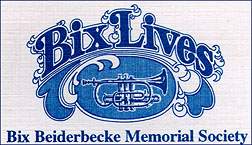
The festivals began in 1972 and have taken place every year without interruption, even in 1995, the year of the big floods in the midwest. (LeClaire Park, one of the main venues of the festival, is located on the banks of the mighty Mississippi river and was under water). Several bands and fans from all over the world gather to keep the memory of Bix alive and to celebrate his musical contributions to jazz. Bix Notes, the official publication of the society, is sent to all members three times a year. It contains detailed information about the festival – the bands, the schedule, application forms.
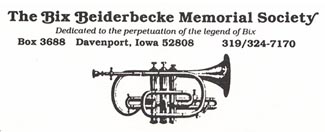
The Bix Beiderbecke Memorial Society office is located in the Kahl building, 311 N. Ripley St. Davenport, IA, 52802. Their web site is at http://www.bixsociety.org
Report on the 1999 Festival
The festival consisted of three distinct types of events: the jazz festival where ten bands played in four venues, the Saturday morning concert at Bix’s graveside, and the Sunday morning liturgy at the First Presbyterian Church.
- The Jazz Festival. The ten bands took turns at playing in LeClaire Park, the Col Ballroom, Danceland, and the Davenport Holiday Inn. The bands, with some exceptions, were pretty good. The amount of music associated with Bix was, except for the selections played by the New Traditional Jazz Band from Maine, minimal. Styles of music varied. At one extreme was the New Traditional Jazz Band from Maine with the most faithful Bixian sound and style. At the other extreme was Bill Allred’s Classic Jazz Band with (to my taste) a most unpleasant sound and a style as far removed from Bix’s as modern jazz or other abominations. In my opinion, one of the highlights of the Festival was David Jellema’s reading on Sunday afternoon at LeClaire Park of the “BIX BEIDERBECKE COMPOSING A SUITE FOR PIANO, 1930-1931: mist, candlelights, cloudy, flashes, dark” by his father, Rod Jellema. The reading of the poem – and the poem itself – made up, in part, for the limited number of of references to Bix during the performances of the bands. David read the poem with a clear voice (in spite of the very long jam session the night before) and injected just the right amount of sentiment in his reading.
- Concert at Bix’s Graveside. This event is, in my opinion, the most important activity of the Festival. About 250 people gathered around the Beiderbecke Familiy Plot. The Quad Cities Antique Ford Motor Car Society added a nice touch by bringing many beautifully restored cars to the site. A tent was set up for the band, the New Traditional Jazz Band form Maine augmented by the legendary Spiegle Willcox. The choice of this band from among the ten bands at the Festival was quite appropriate, as it was the band with the most authentic Bixian sound, with David Jellema playing cornet in a highly Bix-like style. The band played the following selections: I Can’t Believe You’re in Love with Me, At the Jazz Band Ball, On the Alamo, Home, Singin’ the Blues, Louisiana, Love Nest, I’ll Be A Friend with Peasure, Jazz Me Blues, Margie. Spiegle played trombone, sang, and told stories and jokes. He also introduced Grace (Rickey) Bauchelle, the daughter of Doc Ryker (reed player with the Jean Goldkette Orchestra). Rickey attended the Festival with her husband Don. Alann Krivor, the grand nephew of Jean Goldkette, was also present with his wife Mali, and was introduced. The crowd applauded Rickey and Alann entusiastically. Selected portions of the event were video taped by WQAD, a local TV station, and were to be shown at their 6 p.m. and 10 p.m. news broadcast. There was something very special about being near Bix’s grave site, a few days before the 68th anniversary of his death, with a band – The New Traditional Jazz Band of Maine with David Jellema producing an excellent emulation of Bix – playing with respect and authenticity Bix’s immortal music. It was an emotional, and at the same time, joyful experience.
- Liturgy at First Presbyterian Church. Two services were held, at 8:30 a.m. and at 10:30 a.m. Both were full, with “standing room only” left by 8:15 and 10:15, repectively. Every participant agreed that the affair was both joyful and moving. Next to the event at Bix’s graveside, I thought the liturgy was the most memorable event of the Festival. The music was provided by the High Sierra Jazz Band, a great and dynamic group of musicians playing in the traditional style, and the 90-voice adult Sanctuary Choir under the direction of Minister of Music, Steven R. Jobman. The congregation joined in many of the selections by singing, clapping hands, or both. The band played a couple of standard jazz selections before the beginning of the service.
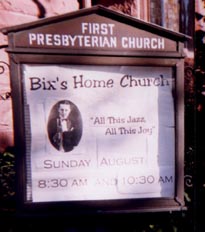
The Rev. Heather Brown-Huston followed with a call to worship: “Praise Almighty God”. Interspersed with scripture lessons, a sermon, and prayers, the High Sierra Jazz Band led the choir and the whole congregation in the following selections: Down by the Riverside, Just a Closer Walk with Thee, He’s Got the Whole World In His Hands, and a second rendition of Just a Closer Walk with Thee. At the end of the service, the band provided the audience with additional standard jazz selections. The sermon – “All This Jazz! All This Joy!”, delivered by the Rev. Sue Howes, emphasized the idea of “call and response”. She noted that at the roots of jazz, of the black church, and, in fact, of life, is the concept of “call and response”. As an illustration of the concept as it is applicable to jazz, the chase chorus between Bix and Tram in You Yook Advantage of Me was played through the public address system. After the benediction, Bix’s solo in Singin’ the Blues was played through the loudspeakers in the church. Hearing Bix’s beautiful, bell-tone sound in the church filled me with a special emotion and I shivered for a second or two. However, I recovered almost immediately, as I realized then and there, more strongly than I had ever before, that Bix’s music was going to last forever.
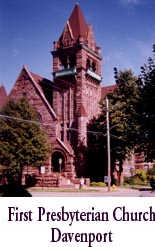
Report on the 2000 Festival
Cover of Church Program
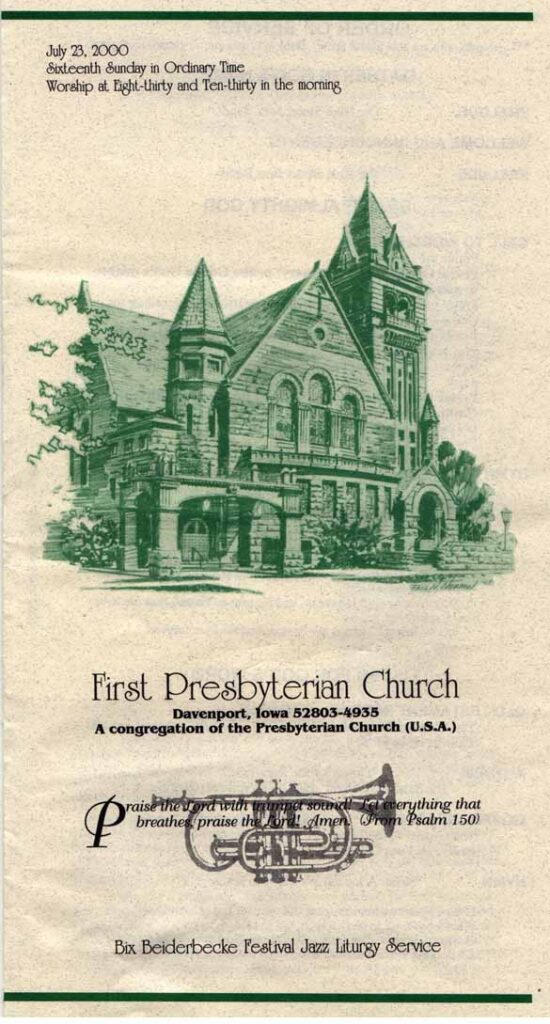
Statue of Bix
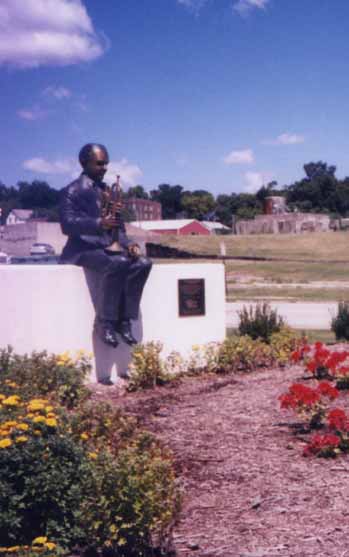
The New Wolverine Orchestra at LeClaire Park
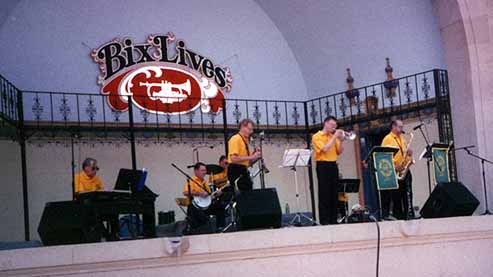
The Sons of Mary Louise Beiderbecke Shoemaker: Ted, Charles Bix and Julien
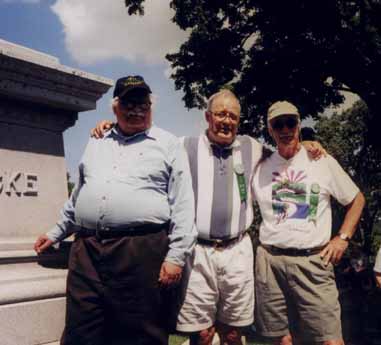
The Jean Goldkette “Daughters”: Grace Bauchelle (daughter of Doc Ryker), Cynthia Willcox (daughter of Spiegle Willcox) and Lee Burnett (daughter of Howdie Quicksell)
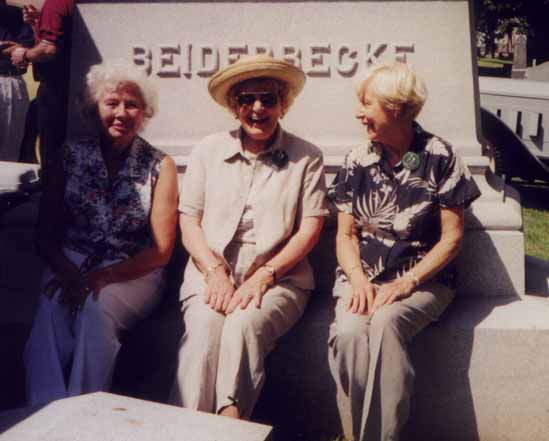
Close-up of Plaque Next to Bix Statue
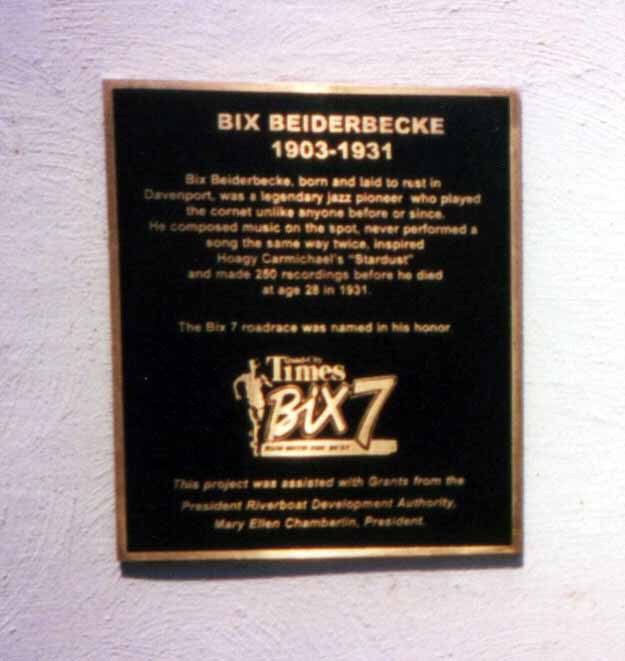
Statue of Bix with Albert Haim
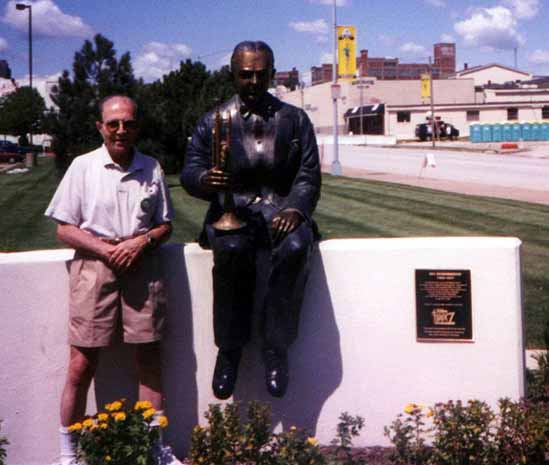
Church Basement Exhibit: The Charles Burnett Beiderbecke (Bix’s Brother), and Mary Louise Beiderbecke Shoemaker (Bix’s Sister) Families
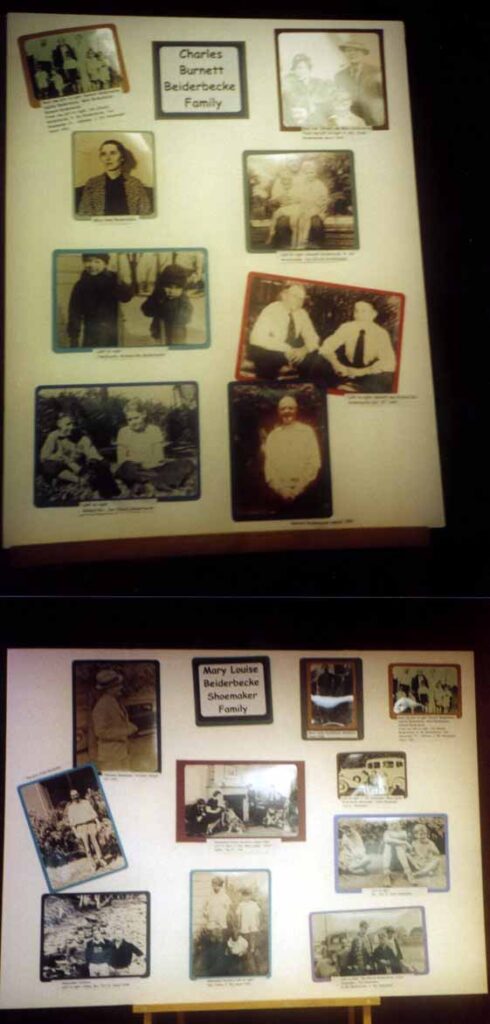
The theme of this year’s festival was “Bix and Spiegle, Together Again.” The three usual classes of activities took place: concerts at LeClaire Park, at the Col Ballroom, at the Danceland Ballroom and at the Holiday Inn; the concert at Bix’s graveside; the jazz lithurgy at the presbyterian Church. The weather was gorgeous, cool in the morning, warm during he day, crisp and dry.
The Concert at Graveside
The New Wolverine Orchestra, by far the best band in the Festival, was chosen to play at this venue: an excellent choice since the New Wolverines strive to preserve the exact sound of Bix’s music. Trevor Rippingale mentioned that the New Wolverines are jazz musicians, and as such are improvisers. However, when it comes to playing music recorded by Bix, they try to play it note for note. I think that this is as it should be. Consider a classic composition. Every note for every instrument is written precisely. The performers bring the composition alive exactly as written. To me, Bix’s records are like classic compositions and modern bands that recreate Bix’s music should treat the recordings as “classic compositions” and bring them alive again by playing them note for note.The tunes played by the New Wolverines were: Singin’ the Blues, I’m Coming Virginia, Davenport Blues, Waiting at the End of the Road, There Ain’t No Land Like Dixieland To Me, I’ll Be A Friend With Pleasure, Half Way Blues (a composition by an Australian musician), Just A Closer Walk With Thee, and The Wolverine Blues. The selections were interspaced by thougtful commentaries from Trevor. He honored the Beiderbecke and Shoemaker family members that were present by dedicating some of the songs to them, he expressed how honored he was that the New Wolverines had been selected to play at Bix’s graveside, he thanked Bix and Spiegle. Trevor and the New Wolverines were a group of gracious and highly competent musicians who respect and bring back, in an authentic manner, Bix’s musical legacy.
A New Statue of Bix
Ted McElhiney, who sculpted the Bix bust near the bandshell in LeClaire Park, has done it again with a full-sized statue of Bix. The statue is located on the property of the Quad-City Times. The plaque next to the statue reads:
BIX BEIDERBECKE
1903-1931
Bix Beiderbecke, born and laid to rest in
Davenport, was a legendary jazz pioneer who played
the cornet unlike anyone before or since.
He composed music on the spot, never performed a
song the same way twice, inspired
Hoagy Carmichael’s “Stardust”
and made 250 recordings before he died
at age 28 in 1931.
The Bix 7 road race was named in his honor
Quad City Times
Bix 7
RUN WITH THE BEST
This project was asssited with Grants from the
President Riverbaot Development Authority,
Mary Ellen Chamberlin, President
Bix’s statue is located behind the statues of two runners, Joan Benoit Samuelson and Bill Rodgers. I have a general view of the plaza with the three satues and a close up of Bix’s sculpture. I was not impressed by the general layout of the plaza nor by the statue of Bix.
Jazz Lithurgy
This event, very well attended, was similar to the one last year. The Blue Street Jazz Band provided the music and did a very good job.
The theme of the sermon was the importance of music in the scripture and in churches. There were a number of interesting photographs displayed in the basement of the church. I took some photographs, and although I was not very successful, I am posting scans.
Miscellaneous
Many members of the Beiderbecke and Shoemaker families were present. I met several of them and they are delightul and friendly people.
Three Jean Goldkette “daughters” were present: Cynthia Willcox (the daughter of Spiegle; Cynthia has been going to Davenport for years), Grace “Rickey” Bauchelle (the daugther of Doc Ryker; this is her second visit to the Festival; her husband Don accompanied her) and Lee Burnett (the daughter of Howard Quicksell; this was her first visit). I felt privileged to have talked to all of them. Their common lineage back to musicians of the Jean Goldkette Orchestra gave these three very nice ladies a special glow and a unique sense of kinship.
Alann Krivor, a grand nephew of Jean Goldkette was at the Festival for his second visit and presented the Second Jean Goldkette Award to Trevor Rippindale and The New Wolverine Orchestra. The award was a conductor’s baton mounted on a picture frame. Alann runs the Goldkette Foundation.
Bix’s house at 1934 Grand Avenue has been restored.
I have been very busy for the last two weeks and will be for the next two weeks. I will scan the photographs I took later as soon as I find some time. I will also add a little bit of information that I obtained by talking to Leslie Swanson.
Report on the 2001 Festival
The theme of this year’s festival was “New Century of Jazz.” The button below reads “Celebrating our 30th Anniversary and the New Century of Jazz.”
General Considerations
In view of the serious floods earlier this year, it is remarkable that LeClaire Park was as beautiful as ever. The arrangements were excellent. The eleven bands had to be taken, at the right time, to one of four venues and, thanks to the organizers and volunteers, the system ran like clockworks. The shuttle bus from the Holiday Inn to the various venues was on time and turned out to be a very convenient way to get around. Unfortunately, the weather did not cooperate: the temperature was in the 90s with humidity to match. But who cares when you are in Davenport, and everywhere you go reminds you of Bix?
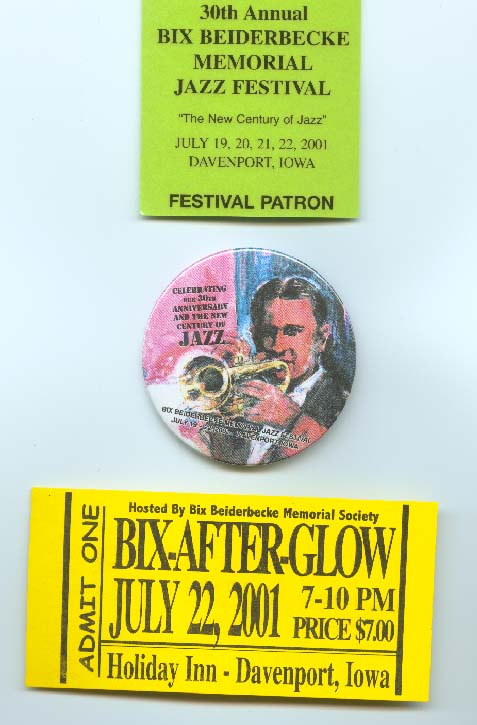
The Bands
By and large the bands played good, traditional jazz from the 1920s. I will single out two bands. First, of course, the Bix Beiderbecke Memorial Jazz Band. This was the band that started the whole Bix Beiderbecke Memorial Jazz Festival, back in 1971, when they flew to Davenport and played at Bix’s gravesite. It is remakable that after 30 years their dynamism and love for Bix has not diminished; if anything they are even more excited about playing in Bix’s hometown. As they had done 30 years ago, the band played at Bix’s gravesite. In my opinion, this is the highlight of the Festival: listening to the band playing Davenport Blues in front of the Beiderbecke Family Plot is a highly emotional experience. Ralph Norton and the Varsity Ramblers brought their authentic recreation of Bix’s music and sound to a highly receptive audience.
The Church Liturgy
2001 is the third year that the First Presbyterian Church is hosting the Sunday morning service with a tribute to Bix. The Barbary Coast Dixieland band was selected to play at the service. The choice was excellent as the band regularly plays in churches. This event is another of the highlights of the Festival. Sitting in the church that Bix once attended regularly and listening to the music and the comments about Bix is, to repeat what I said earlier, an emotional experience. The event included an appearance by the Bix Sunday Young People’s Octet, shown in the photograph on the right. In addition, the basement of the Church had an exhibit of church records, documents and photographs of Bix and family members. Tom Vaccaro, church member and Elder was signing copies of of his portrait of Bix, shown below.
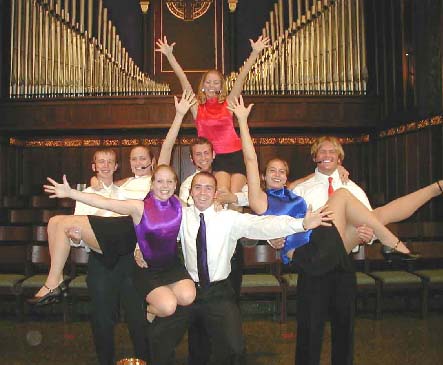
The Davenport Public Library
The basement of the library has several items related to Bix hanging on the walls: Posters from the Festival, photographs of Bix, newspaper articles. I will post photos that I took as soon as I get them developed. I would like to highlight one of the newspapers articles. Under the title “Library Gets Tapes”, there is a photograph followed by the text, “Jim Grover, right, representing Miami University Radio presents Robert Kellenberg, chairman of the Davenport Public Library Board of Trustees original tapes of the 19 half-hour radio shows, including interviews with many musical greats who knew and admired Bix Beiderbecke. Grover saays the program will be aired on national radio network.” I tried to obtain a copy of the newspaper, but, in spite of enormous cooperation from the library staff, I was unable to do so. I need the date the story was published, and I will pursue this in the near future.
The library has an almost complete set of “Polk’s Davenport City Directory”. I look at all the volumes that were available and here is what I found.
1919. Leon B. Beiderbecke listed at 1934 Grand Avenue as brds (boards, lives at ).
1921 and 1922. L.B.B. listed as student, same address.
1923. L.B.B. not listed.
1924, 1925. L.B.B listed as musician, same address.
1927-1930. L.B.B not listed.
1931. L.B.B. listed as musician, same adress.
I made a copy of “Ode to Bix” by Earl A. Rohlfe and will post on this in the appropriate section in the near future.
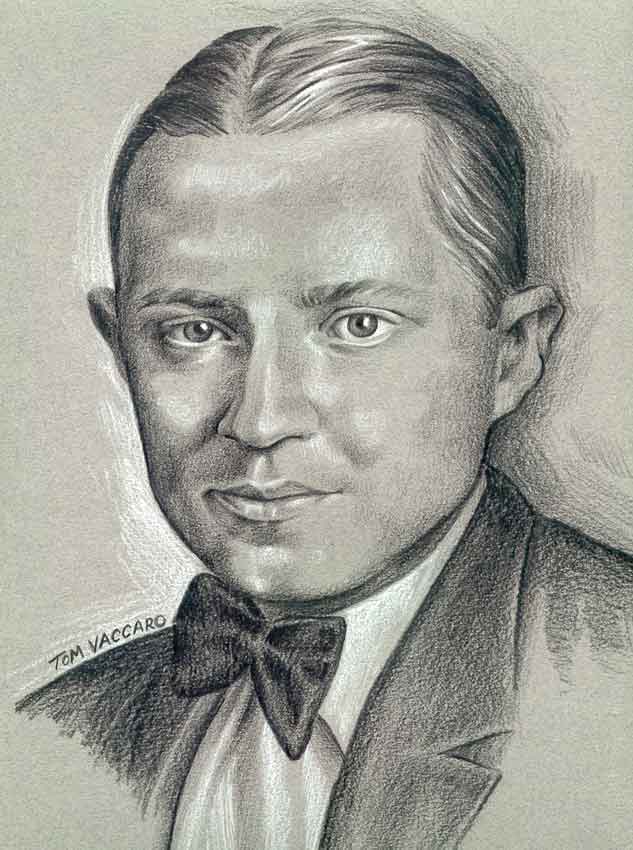
A Cousin of Ben Pollack
I had the pleasure of meeting Millie and Milt Libman. Millie and Milt are the parents of Paul Libman, a talented pianist who was at the festival with Ralph Norton’s Varsity Ramblers and contributed, with his excellent piano solos and accompaniment, to the band’s authentic 1920s sound. Millie is Ben Pollack’s cousin. I asked her if she and Ben had ever talked about Bix. It turns out that Millie is 14 years younger than Ben and she knew Ben when she was a little girl: there was no mention of Bix in their conversations. But Ben Pollack certainly knew Bix. The following is a quote from Richard Sudhalter’s “Lost Chords”. “Drummer Ben Pollack, then working casuals around town, had been an admirer of Brunies, Pettis, and Mares since jamming with them out at Fox Lake, Illinois, a popular resort area up near the Wisconsin state line. His soon became a familiar face around the Friar’s cellar bandstand at Wabash and Van Buren. Other young whites were frequent visitors: nineteen-year old Bix Beiderbecke, then faring none too well at Lake Forest Academy, would bring his battered cornet and asked to sit in playing ‘Angry’.” Evidently, Bix and Ben must have known each other well. There is another connection between Bix and Ben.In 1965, Ben Pollack and Steve Loyacano donated a cornet to the Louisiana State Museum Jazz Collection. According to Ben Pollack, this is a cornet that Bix gave to Ben in 1928.
Bill Donahoe and Doc Ryker’s Saxophone
At last year’s Festival, Grace “Rickey” Bauchelle, the daughter of Doc Ryker, met Trevor Rippingale, the leader of the New Wolverine Orchestra of Australia. Trevor had asked Rickey if she had her father’s alto saxophone. Rickey told Trevor that she did not have it and did not know what had happened to it. The mystery of the whereabouts of Doc Ryker’s saxophone has been solved. Rickey was present at this year’s Festival, as was the legendary Bill Donahoe.
Bill, of course, is the originator of the Bix Festival. [See the article just below this one]. I have corresponded with Bill since 1998. He sent me loads of precious information (including irreplaceable original photographs) about the pilgrimage of the Bix Beiderbecke Memorial Jazz Band of New Jersey to Davenport in 1971. I knew him, through our correspondence, as a generous and considerate individual. It was a distinct pleasure and privilege to meet him, and his charming wife Chickie, in person at this year’s Festival. Considering the enormous impact that Bill has had in the world of Bixology, he is a rather modest individual. Whenever he is praised for what he has accomplished, he deflects the compliments toward his friends in the Bix Beiderbecke Memorial Jazz Band and takes no credit for himself. A real gentleman!
After this digression, let us get back to Doc Ryker’s saxophone. Since Doc and his family lived in the East Coast in the 1960s, I imagined that he would have been invited to the “Bix Lives” gatherings in Bill’s house. When I asked Bill if Doc ever attended his tributes, a spark of special recognition lit his eyes and he said, “Of course. What a great guy he was.” And he added, “You know that Doc gave me his saxophone.” I did not know. Bill continued, “When I moved from New Jersey I gave Doc’s saxophone to Vinnie [Vince] Giordano. I couldn’t think of a better keeper of the flame than Vinnie. He in turn will pass it on to another deserving individual.” I totally agreed with Bill and then called Rickey to meet Bill. It was like a family reunion of relatives who had not seen each other for a long time. Rickey was so pleased to find out what had happened to her father’s saxophone and they went on talking about Doc and the old days… The scene practically repeated itself with Bill Barnes, the leader of the Bix Beiderbecke Memorial Jazz Band. Bill B. also knew Doc and had a special affection for him. Bill B. was aware that Doc’s saxophone had gone first to Bill D. and eventually to Vince Giordano. It was indeed a family reunion, a family of Bixophiles.
Closing Comments
I have been corresponding now for quite a while with a number of Bixophiles from across this country and around the world. I met many of them in person for the first time at the festival. They are too numerous to be mentioned individually, but to all of them I want to express the pleasure of meeting them and my gratitude for their support of the Bixography.
Finally I want to express publicly my thanks to Rich Johnson, not only for what he does for the Bix Festival, but for his help whenever I ask him for information. As an example, let me cite that I considered the possibility of visiting the Blue Lantern Inn in Lake Hudson, Indiana on my way to the Chicago Airport. In spite of the fact that Rich was extemely busy with the members of the various bands, the arrangements, and the crisis that develop, he took the time to make a copy of a detailed map to Lake Hudson and gave me instructions as to how to find the cabin where Bix had lived in the summer of 1926.
I look forward to the 2002 Festival and the ones beyond.
Report on the 2002 Festival
The theme of the 2002 Festival was “Jazz, the Sound of America.” The motto of the festival was “There are No Strangers at the Bix Festival.” You can see the poster on the image at the right.
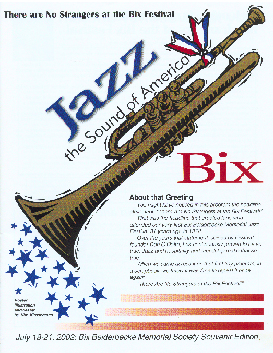
The 2002 edition was another great Festival in a series that began in 1972. The format was very similar to the one in 2001. There were eleven bands playing in four venues: the Col Ballroom, Danceland, Le Claire Park and the Holiday Inn. The program provided the following description of the various venues.
Le Claire Park
This green grassy setting has always been our “home” venue. It’s where many persons gathered from all over the world to first celebrate the genius of Davenport-born Bix. Here one can relaz in a most unusual park atmosphere and enjoy super bands performing the music of Bix’s era in a grand old, authentic “Roaring ’20s band shell. Where else could one savor top-of-the-line jazz while watching big riverboats, with their huge strings of barges, pass by or see an array of ppleasure boats, form yachts to moorboats, and, at night, bask in the glow of he lighted Centennial Bridge, arching nearby over the Mississippi river?
Col Ballroom
The Col Ballroom, where Bix often played, is one of the oldest, and best-preserved ballrooms still in every day use in the Uniited States. It has served the Bix Society faithfully and well since the first Friends of Bix Cocktail Party was held 31 years ago, and has hosted the party and our jazz concerts eversince. The Bix Cocktail Party, open to everyone, inttroduces four ofr five of the Festival bands on the night before the regualr concerts begin. It’s always a joyous occasion, with friends sitting together at tables in front of the bandstand, dancers, many in “Roaring ’20s” dress, whirling around the floor, under the spinning globe spreading stardust light. The Col Ballroom seats about 700, and there are two bars and refreshement stands, as well as a souvenir section.
Danceland Ballroom
Just a few jazz beats, a skip and a jumpfrom the Col Ballroom and Le Claire Park is another lovingly and authentically restored ballroom from out of the past, Danceland. Here Bix’s golden cornet once bounced perfect notes off the assive overhead beams. Though the bandshell is of midest size, it was big enough for the huge Paul Whiteman Orchestra to squeeze onto when the “King of Jazz,” with whom Bix was a featured player, visited Davenport in the “Roaring ’20s.” This lovely old period ballroom’s owners went to great trouble and exponse to recreate it much as it was in Bix’s day.
Davenport Holiday Inn
Though much younger than the Col and Danceland, the Holiay Inn has been at the center as Bix Beiderbecke Memorial Jazz Festival history has been made. There might not have been a Bixfest had not the Bix Beiderbecke Memorial Jazz Band of New Jersey, with leader Bill Donahoe, elected that electrifying jam session at the Davenport Holiday Inn way back 32 years ago, 31 years ago, in 1971. They’d come to visit Bix, their idol’s odl Davenport haunts, playing on a riverboat and over Bix’s grave, but the jam session was so great that hundreds squeezed into the Holiday Inn to take part. It is THE place to be for those far-into-the-wee-hours jam session, following the regularly scheduled evening concerts. It’s also the site for our popular “Bix AfterGlow Party,” on Sunday nights, after the regular Le Claire Park Sunday afternoon concert, officially ending the Festival.
Concert at Bix’s Gravesite
In my opinion, the highlight of the Festival is the traditional concert at Bix’s gravesite, in Oakdale Memorial Park. The Bix Beiderbecke Memorial Jazz Band of New Jersey started the tradition in 1971, and it has been followed each year eversince. This year, the honor of being the band at Bix’s gravesite fell upon the New Wolverine Orchestra. This is a first-class group of Australian musicians led by Trevor Rippingale who describes their music as follows, “Our central focus is to celebrate the music of Bix Beiderbecke and the musicians and bands with whom he played. ” Trevor plays mostly alto sax and clarinet. Geoff Power is on cornet, Robert Smith on piano, Harry Harman on bass, Strewart Binstead on guitar and banjo, Jim Elliott on trombone and Neil (Chauncey) Macbeth on drums. They play music from the Wolverines, the Trumbauer, the Goldkette and the Whiteman bands, arranged for seven instruments. Of course, the New Wolverines do a great job with the music from the smaller bands. But it is remarkable how this small group of musicians recreate very well the music of the huge Whiteman band. The New Wolverines were in Davenport for the 2000 Festival and had played at Bix’s gravesite. Most of the people that I talked to who had seen the New Wolverines in their previous appearance agreed with me that the band sounds even better than they did two years ago! They played the following numbers: Davenport Blues, I’m Coming Virginia, West End Blues, I’ll Be A Friend With Pleasure, Black and Tan Fantasy, There Ain’t No Land Like Dixieland To Me, Blue River, Riverboat Shuffle, At the Jazz Band Ball and Jazz Me Blues. Trevor prefaced every song with some comments and historical remarks. Since the New Wolverines were doing a tribute to Bix, he included two numbers from Bix’s contemporaries, Louis and Duke, as tributes that they would have like to make on behalf of Bix. It was a memorable presentation and we should all thank Trevor and the New Wolverines for their extraordinary efforts to keep Bix’s music alive. Those who have never attended the tribute to Bix at gravesite cannot understand what it represents. Being near the place where Bix is buried, seeing the Beiderbecke family stones -in particular Bix’s stone with floral offerings (one, a lone red rose deposited on the stone every year by Bix fan Ruediger Machwirth)- and listening to Bix’s music played by an excellent group of musicians is an irreplaceable experience.
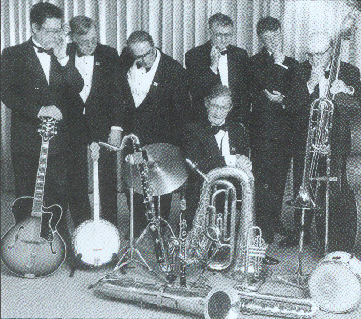
[As an aside, I would like to point out that Trevor referred to the clarinet solo in I’ll Be A Friend With Pleasure as a Benny Goodman solo. Of course this is a controversial subject. I, and perhaps a few others, believe that Goodman played the solo. On the other hand, many Forum participants and experts believe that Jimmy Dorsey played that solo.]
AfterGlow
After three days of hectic schedules, on Sunday evening, a few hundred die-hard fans remain in Davenport and get together at the Holiday Inn for the final concert. This year, we had a special treat. Josh Duffee and His Orchestra gave us a recreation of the legendary Jean Goldkette Orchestra. I had heard Josh and his band throughout the week. They play music -as Josh tells us- from the ’10s, ’20s and ’30s. Josh thrives to bring in an authentic sound to the numbers he plays -and succeeds admirably. The 15-piece orchestra consists of three trumpets, four reeds, two trombones, banjo/guitar, flute, violin, xylophone, bass and drums. For the special Afterglow concert, Josh was joined by the members of the New Wolverine Orchestra. With the addition of four vocalists (three playing the role of the Keller Sisters) Josh was leading a 26-piece orchestra! The orchestra played, with one exception, an all-Goldkette program. They started with a rendition in slow march tempo of “Valencia.” It turns out that in the legendary battle of the bands between the Jean Goldkette and Fletcher Henderson orchestras at Roseland in October 1926, the Goldkette band started – at the astonishment of the patrons- with Valencia. Following “Valencia,” Josh and his orchestra went on with a dynamic rendition of “My Pretty Girl Stomp.” That was an exact replica of the 1927 version by the Goldkette orchestra. Each musician reproduced exactly the notes played by the original musicians in the recording. But that is not enough. One of the key features of the Goldkette sound was the enormous drive brought in by every musician. Well, I tell you, the Josh Duffy orchestra had that drive. Those of you who know me realize I am highly demanding when it comes to have the sound of the 20s replicated by modern musicians. I was extremely astonished -and gratified- to find that authentic 20s sound in the performance by Josh and his orchestra.
The evening went on with great Goldkette numbers: “I’m Gonna Meet My Sweetie Now,” “Proud of A Baby Like You” (with three delightful young ladies doing a great reproduction of the Keller Sisters and Lynch vocal in the original recording), “Sunday” (by request from the audience, with the “Keller Sisters” again), “In My Merry Oldsmobile” (the fox-trot version), “Blue River” and “Clementine.” The band closed with a composition by David Basden -“Halfway Blue” with magnificent solos by Geoff Power on cornet and Trevor Rippingale on alto sax. It was an amazing tour de force with a fantastic emulation of the Goldkette sound. At the end of the performance, Alann Krivor, the grandnephew of Jean Goldkette, presented Josh “The Jean Goldkette Award for Excellence” in the form of a framed baton. The audience -many, local residents from the Quad City area- was ecstatic. Josh is to be commended not only for the quality of the music he recreated but also by his approach and attitude. Throughout the festival, Josh emphasized the contribution of Frank van Nus to the music. The arrangements were transcribed by Frank from the original Goldkette recordings. [I wish Frank had been at the Festival. He would have been so pleased to see and hear the results of his travails]. Josh also repeatedly acknowledged his gratefulness to Rich Johnson for his encouragement and for hiring the band for the Festival.
Josh is concerned about historical accuracy and provided a little background to each song the orchestra played. It is refreshing to see a nice, 22-year old young man who gives credit where credit belongs and who admires and appreciates the musical contributions from musicians who made their marks in the ’20s and ’30s. The task of finding 14 musicians, obtaining charts, rehearsing and coming up -in a relatively short time- with an accomplished orchestra and a high-quality emulation of the Jean Goldkette sound is daunting, to say the least. Josh, through hard work and determination succeeded beyond any expectations. Josh joins a series of distinguished Goldkette awardees -The Bix Beiderbecke Memorial Society, Spiegle Willcox, and Trevor Rippingale and The New Wolverines. The Goldkette Foundation Award to Josh was highly deserved.
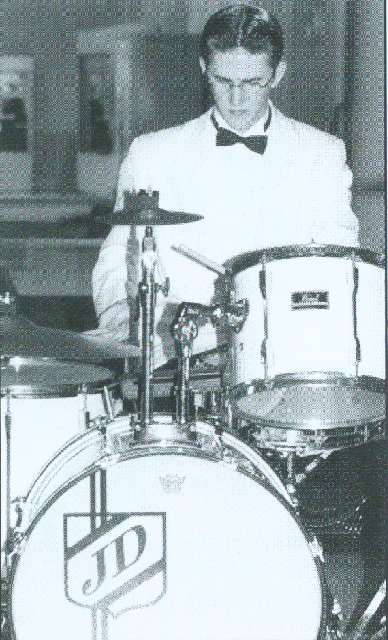
The Josh Duffee Orchestra at Danceland, July 2002
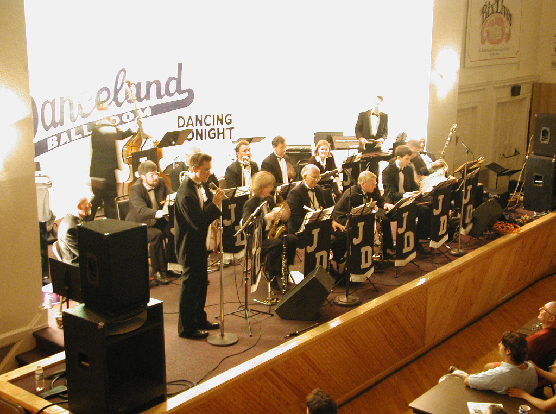
Josh Duffee receiving the Goldkette Award from Jean Goldkette’s grandnephew, Alann Krivor
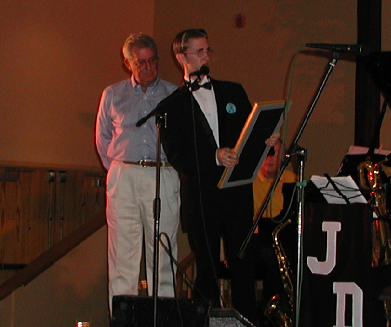
Trevor Rippingale (leader of the New Wolverine Jazz orchestra), Crystal Snow (flute player in the orchestra), Josh Duffee, Ray Voss (president of the Bix Beiderbecke Memorial Society) and Alann Krivor.
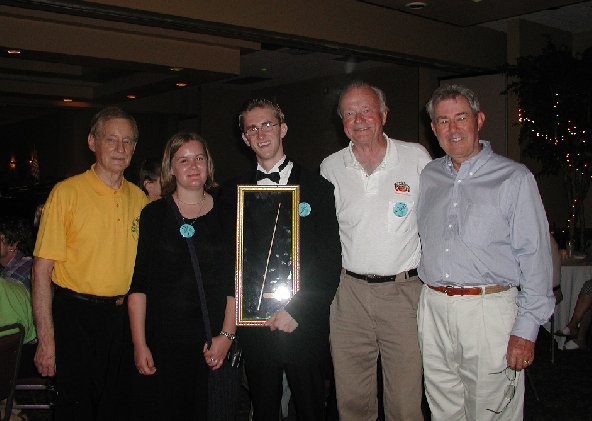
Final Comments
Bixophiles from around the world owe a great debt of gratitude to all the officials in the Bix Beiderbecke Memorial Society. I regret that I do not know most of them, and therefore I will name only Ray Voss, the new president of the Society, Rich Johnson, the musical director for the Festival, and Annie Pert, the treasurer for the Society. They and their fellow officials and volunteers- under very tight and difficult financial constraints- manage every year to bring to completion a great Festival to keep the memory of Bix alive. We are looking forward to next year’s festival. I am confident that, 2003 being the one hundredth anniversary of Bix’s birth, the 2003 Festival will be very special.
I am grateful to Alann Krivor for kindly sending me copies of the photos from the Festival.
Report on the 2003 Festival
Generalities
This was the very special festival: the one to celebrate Bix’s 100th birthday. And indeed, it was special. The theme was “Preserving A National Treasure.” Attendance was very high, great bands played excellent music –several in the style of Bix- and a large contingent of members of the Beiderbecke family were present. The weatherman cooperated with temperatures in the 80s and not too much humidity. As far as I could tell, everything worked like a well-regulated clock. The officials of the Bix Beiderbecke Memorial Society did a great job of organizing the various events, the volunteers were friendly and helpful.
I urge all Bixophiles to join the society, even if they do not plan on coming to the festivals. Here is the page on membership from the society’s website http://www.bixsociety.org/
Join The Bix Jazz Club Today
Bix Beiderbecke Memorial Society Jazz Club Members become part of a very unique organization.
Not only do members help the non-profit Society meet the heavy financial goals of presenting the annual festival, but they also receive benefits themselves. One important benefit of the $l5 annual membership fee is the big, acclaimed Bix Notes Newsletter, published three times a year to keep members up-to-date on upcoming Festival events, Bix Society information of interest, special events, ticket and motel information, maps and much more.
There are members from all over the world! Members also receive certain discounts. In the early days of the Bix Society, the newsletter was a single mimeographed sheet, with information on both sides. But for more than 20 years, it has been a slick, professionally-edited and printed publication of from 8 to 10 pages, complete with photographs and graphics. There are Spring, Summer and Fall editions.
If you’re interested in Bix Beiderbecke, the musician and his legend, and what is being done by admirers like you to perpetuate his accomplishments – Bix Jazz Club membership, and Bix Notes is for you.
Just fill out the membership form and make checks available to Bix Beiderbecke Memorial Society, P.O. Box 3688, Davenport, Iowa 52808. Questions: (563) 324-7170.
The Music
I will mention only five of the bands (in strict alphabetical order). These were the bands that brought back the sound and spirit of Bix’s music.
The Bix Beiderbecke Memorial Jazz Band
This band started the whole nine yards back in 1971. The two Bills, Bill Donahoe (on washboard) and Bill Barnes (on cornet) displayed the same enthusiasm about Bix that they have had for several decades. Other members of the band (also highly enthusiastic about the music they were playing) were Les Deutsch (piano), Kirk Prebyl (drums), Noel Kaletsky (sax), Rick Kittel (trombone), Bill Lezotte (banjo), Bruce McNichols (clarinet) and Sam Notto (tuba). They played in a dynamic manner and although they did not copy the arrangements in Bix’s records, they played with a highly Bixian “feeling.” This was the band, appropriately, that played on Saturday morning at Bix’s gravesite. More about that below.
Josh Duffee’s Orchestra
I became acquainted with Josh and his band in last year’s festival. Since then, I heard them play in Racine, WI, earlier this year at Phil Pospychala’s Tribute to Bix and in Davenport in March 2003 in connection with the celebration of Bix’s 100th birthday. The band consists of Josh Duffee (leader and drums), David Abdo (string bass), Scott Morschauser (xylophone), Julie Craighead (sax and clarinet, Matt Craighead (sax and clarinet), Kelly McNichols (sax and clarinet), Kent Rockow (trumpet), Greg Kitzpatrick (trumpet), Alan Napper (trumpet), Bruce Bogen (trombone), Chuck Conella (trombone), Greg Schwaegler (violin), Crystal Snow (flute), Scott Silver (banjo/guitar), John O’Meara, Daphne Biddal, Holly Free, Venessa Free (vocals). The band was augmented by Frank van Nus (on trumpet), a contributor to the Bixography forum and music teacher in the Netherlands who transcribed the Jean Goldkette records for Josh. The band has expanded its repertoire beyond what Goldkette recorded in the 1920s. I found that the band sounds a lot tighter this year than last year. I also enjoyed Frank leaving his chair and assuming the role of bandleader on a couple of occasions (one of them, My Pretty Girl). Frank received the 2003 Jean Goldkette Foundation award during the “Afterglow” event. The award, quite appropriately, was a framed baton. Overall, the band has an excellent sound and comes close to emulating the sound of the “real” Goldkette band from the 1920s.
The New Wolverine Jazz Orchestra
This band comes very close to emulating the sound of the 1920s. Although, the band consists of only seven musicians (Trevor Rippingale, leader and reeds; Geoff Power, cornet; Peter Locke, piano; David Basden, sousaphone; Stewart Binstead, banjo/guitar; Jim Elliott, trombone; Neil “Chauncey” Macbeth, drums), they are able to perform and emulate the sound of much bigger bands (Goldkette or Whiteman). The band was one of three who participated in the “Afterglow” event. The New Wolverines are an excellent group of talented musicians. My favorite session by this group was on Thursday afternoon at the Putnam Museum. The Wolverines played an all-Bix tunes concert, several tunes going back to the 1924 Wolverine Orchestra recordings. The excellent musical proficiency of all the musicians in the orchestra and their deep feeling and understanding of Bix’s music is to be commended.
Ralph Norton’s Varsity Ramblers
I have seen the Varsity Ramblers several times in Davenport. Ralph (leader and cornet) strives and succeeds in producing an authentic 1920s sound. His fellow musicians were Armin J. Jack Meilhan (banjo/guitar0, Tom Bartlett (trombone), John Gill (drums), Mike Montgomery (piano), Glenn Meyer (reeds) and the muti-talented Vince Giordano (string bass, tuba, bass saxophone). Ralph may have an unusual (to put it mildly) sense of humor, but his band has an excellent sound.
West End Jazz Band
I have seen this band in the past, and they seem to get better and better. The musicians are Mike Bezin (leader and cornet), Leah Bezin (banjo/guitar/vocals), Frank Gualtieri (trombone), Mke Walbridge (tuba), Greg Dearth (reeds), Mike Albiniak (drums). The band specializes in hot dance band arrangements and sounds just like one of the hot dance bands fo the 1920s. The ensemble as well as solo work is excellent and Mike plays cornet with an unmistakable Bixian flavor.
The Gravesite Concert
Traditionally, Saturday morning of the festival finds people gathering around the Beiderbecke family site in Oakdale cemetery and one of the bands at the Festival plays music associated with Bix. This year, the band was the Bix Beiderbecke Memorial Jazz Band. I am happy that this was the chosen band as we have so much to thank them for. The leader of the band, Bill Barnes, also acted as MC. He fulfilled his obligations with grace, humor and feeling. The band started the music by playing the traditional “Just A Closer Walk With Thee” and played nothing but hymns. Among the tunes, I cite Down by the Riverside, Take My Hands Precious Lord and When the Saints Go Marching In. I think it was an excellent choice of tunes for the special 100th Bix birthday celebration. The audience participated enthusiastically. The band received a highly deserved standing ovation at the end.
Bill also introduced Howard Braren, great-grand son of Henry Beiderbecke, brother of Bix’s grandfather Carl (also known as Charles and as “Opa.”). Howard in turn introduced other members of the family who in turn introduced other members… I may have missed some, but here are some of the family who were introduced. From the Carl Beiderbecke side (Carl was Bix’s grandfather): Richard Bix Beiderbecke and his children, Chris and Liz (Richard is the only surviving son of Charles “Burnie” Beiderbecke, Bix’s brother; Ted Shoemaker; Charles Bix Shoemaker and his son Charles Bix, Jr.; Julian Shoemaker and his daughters Linda and Laura. The three Shoemakers brothers are the sons of Mary-Louise, Bix’s sister. From the Henry Beiderbecke (Bix’s granduncle) side of the family, we had Howard Braren, Fred Beiderbecke, Henry “Hank” Beiderbecke and Sally Beiderbecke. So it was quite an interesting gathering of members of the Beiderbecke family.
The Festival Jazz Lithurgy At Historic First Presbyterian, Bix’s Home Church
Continuing a tradition begun five years ago. There were two services, one at 8:30 and one at 10:30. I attended the 8:30 service. The Blue Street Jazz band provided the music. Reverend Sue Howes, Associate Pastor Emerita, gave the sermon “Beyond the Melody.” As usual, the service was of the highest calibre in terms of music, sermon, singing and dancing by the Bix Sunday Jazz Ensemble. In the basement, church goers enjoyed an excellent exhibit of photographs of Bix and his family.
Conclusion
I must also mention that I enjoyed very much meeting several of the members of the Beiderbecke family. They are invariably friendly and nice people.
All in all, a great chapter in the history of Bix Festivals in Davenport. Thanks to Ray Voss, Rich Johnson and all the officials of the Bix society for their selfless dedication to the preservation of Bix’s musical legacy.
Images
Bill Donahoe and his washboard
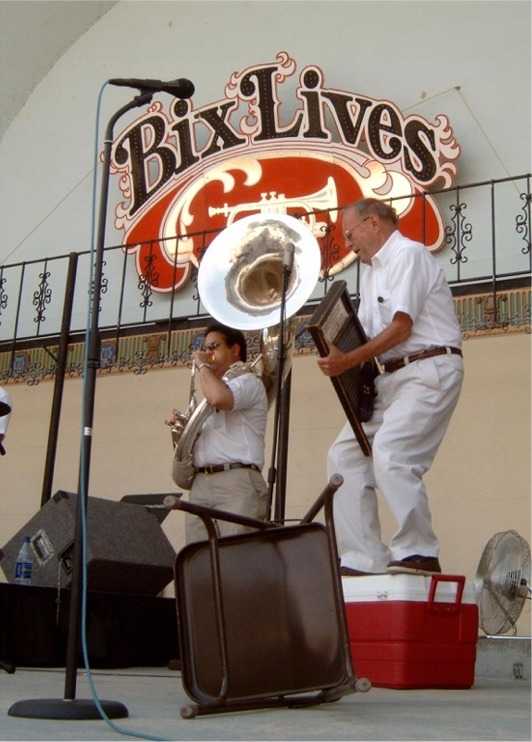
Albert and Danish Bixophile Flemming in front of Bix’s bust in LeClaire Park
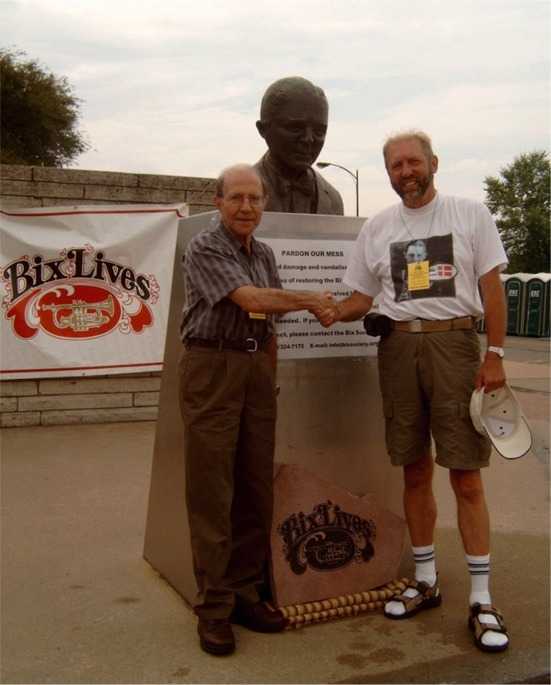
Close-up of image in Flemming’s T-shirt. (Designed and created by Flemming)
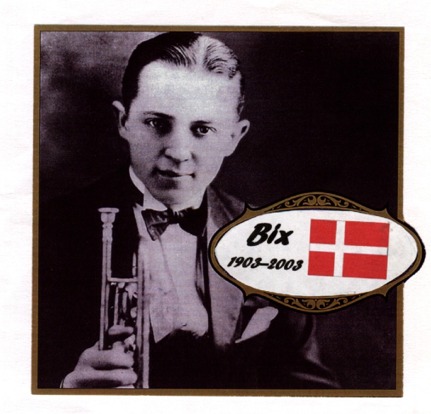
Concert at gravesite
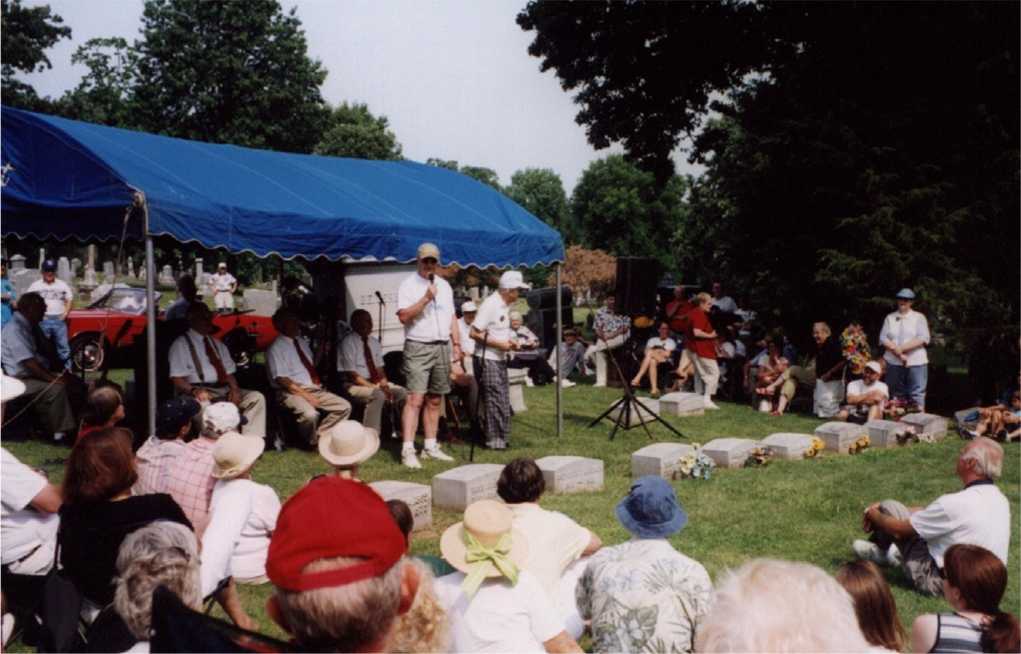
People and cars in front of Col ballroom
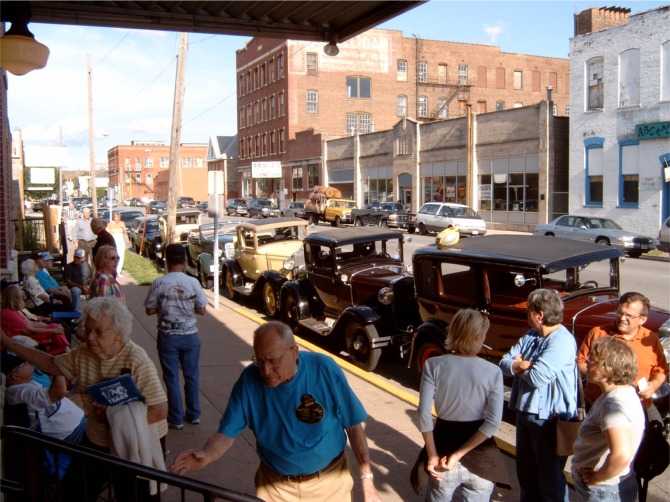
The New Wolverine Jazz Orchestra in the Holiday Inn
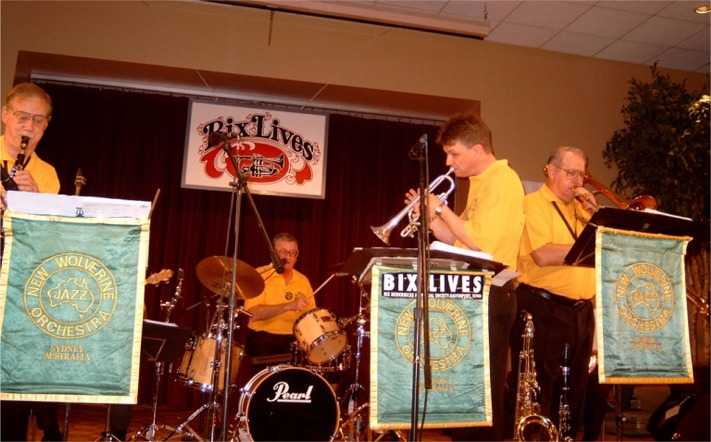
The Bix Beiderbecke Memorial Jazz Band in the Beiderbecke family cemetery plot
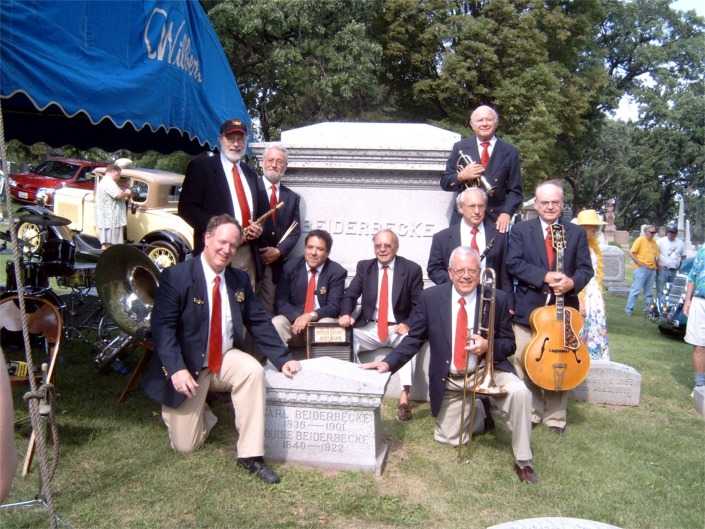
The West End Jazz Band at LeClaire Park
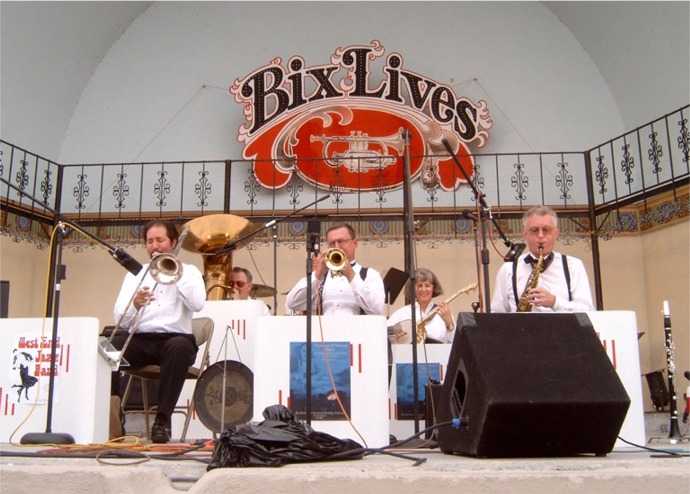
Thanks to Bixophile Flemming Thorbye for the above photos.
The First Presbyterian Church in Davenport
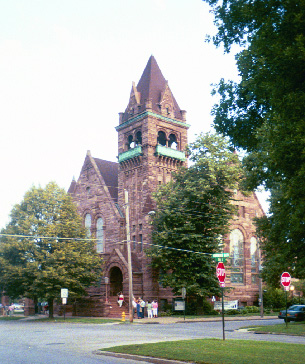
Announcement of Jazz Church Liturgy
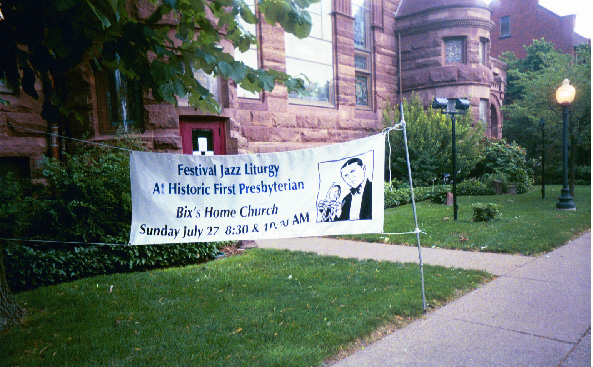
Bill Barnes addressing the audience at gravesite concert
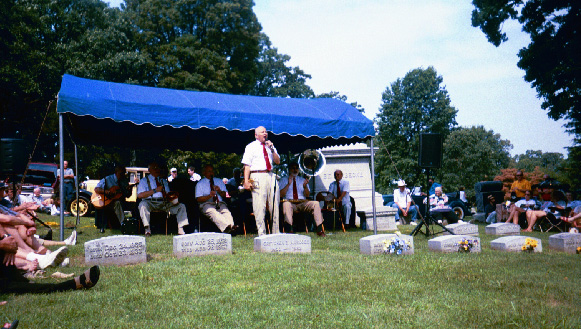
Ralph Norton’s Varsity Ramblers at LeClaire Park
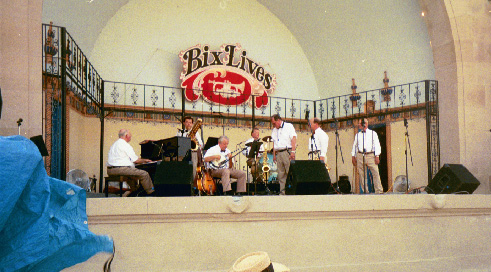
People gathering outside Holiday Inn to go to the gravesite concert
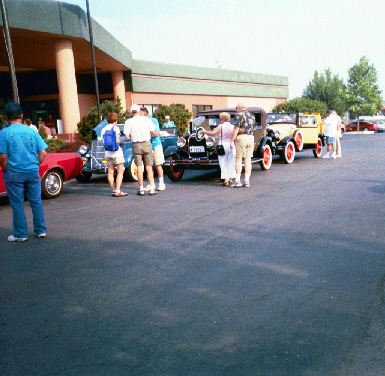
Report on the 2005 Festival
- The Music
In my opinion the three best bands were, in alphabetical order, Josh Duffee and His Orchestra, Spats Langham and His Rhythm Boys, and the West End Jazz Band. The “boys” in Spats band are Mike Durham (cornet and spokesman, great sense of humor); Norman Field, reeds; Frans Sjostrom, bass sax; Nick Ward, drums; Paul Munnery, trombone; Jeff Barnhardt, piano. Spats plays guitar, banjo, ukelele, and sings. I have often said that it is very difficult to find a drummer who plays in an authentic 1920s style. In fact, it seems to me that it is the most difficult instrument use in the emulation of the sound of the 1920s. Nick plays drums in a completely authentic manner -and with flair. All the musicians were first-class. I have a weakness for the bass sax, and Frans is one of the foremost exponents. The rhythm he provides and his improvisations are superb. Norman is a terrific reed player. I did not know Spats. I was so favorably impressed by this multi-talented musician! Vocal is another difficult part of 1920s music. Modern singers just don’t have it. Spats does. You should have heard him in his emulations of Cliff Edwards and many other vocal renditions. Great personality.
Josh Duffee’s orchestra is improving year by year. They add new tunes to their repertoire, thanks, in part, to some great transcriptions by Frank van Nus (who was a guest trumpet player with Josh throughout the festival). On opening night on Thursday evening, Josh and His Orchestra played at the Col Ballroom and were joined by Randy Sandke playing Bix’s Bach 620 cornet. Randy soloed on “In My Merry Oldsmobile” and “Jazz Me Blues.” What an outstanding musician he is.
The West End Jazz band also keeps on improving yera by year. They have an authentic 1920s sound, whether they play jazz or hot dance band tunes. - The People
There were several forumites present at the festival. It was good to meet those I had not met before, and re-encounter those I knew. I spent quite a bit of time with Randy on Thursday morning at the Beiderbecke Inn. Considering his remarkable standing as one of the best New York jazz musicians, I found him to be a straighforward, no-nonsense, and very friendly individual. I thoroughly enjoyed my conversations with him. I played for Randy the three takes of Miller’s “Cradle of Love” and the three takes of “When A Woman Loves A Man” by Roger Wolfe Kahn. I asked his opinions about the identities of the Bixian soloists in the two tunes. His reply was unequivocal, competent emulators, but certainly not Bix. The characteristic Bix vibrato and his articulation were missing, Randy told me. In addition, he did not think that the soloist in any of the takes of the two tunes exhibited any signs of weakness.
I also asked him about the two takes of “Cooking Breakfast for the One I Love” by Roger Wolfe Kahn, and the single take of “Cooking Breakfast for the One I Love” by Annette Hanshaw. His firm reply: the soloist in the two takes of “Cooking Breakfast for the One I Love” was not a jazz musician. Since Muggsy was a jazz musician, the soloist in “Cooking Breakfast for the One I Love” by Roger Wolfe Kahn is not Muggsy, Randy tells me. - The Saturday Morning and Sunday Morning Concerts
The band at Bix’s graveside was the Bix Beiderbecke Memorial Jazz Band. As usual, they did a very good job of playing a mixture of Bix’s tunes and some hymns. Bill Barnes, the leader of the band, has an engaging personality and told some amusing anecdotes. The Sunday morning liturgy at First Presbyterian Church, Bix’s chidlhood church, is always a worthwhile event. There was a good sermon about Bix’s mother by Rev. Richard Wereley. - The Beiderbecke Family Piano
This is the piano that the Beiderbecke family bought in 1925. It was taken to Colorado by Charles Beiderbecke (Bix’s uncle) and donated to the Putnam Museum in the 1990s, I believe. It was rolled out from its usual location for two excellent pianists to play, James Harding and Rod Biensen. - The Goldkettte Award
The recipient of the 2005 Goldkette Award is none other than Rich Johnson, music director for the Bix Festival, member of the Bix Beiderbecke Memorial Society Board, guitarist, Bix researcher/historian, who is the world expert on anything related to Bix in Davenport and Bix’s family. Congratulations to Rich! A highly deserved honor for all his contributions to Bixology and to keeping Bix’s music alive.
Photographs
River Music Experience
Benny Goodman and Jelly Roll Morton Poster
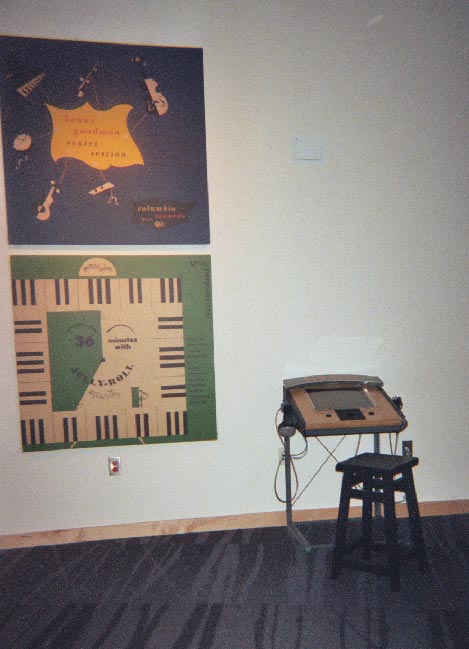
Entrance to Second Floor: Bix Images
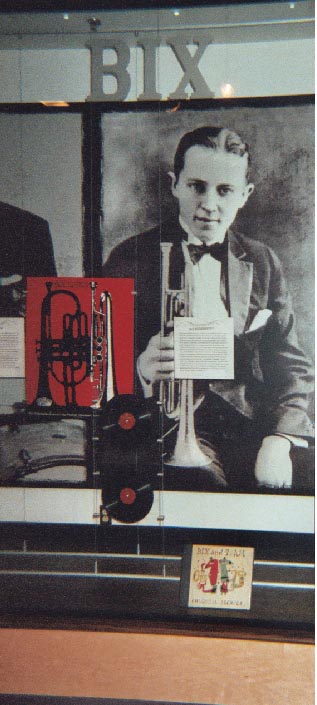
Bix and Tram Columbia Album, Wall Size
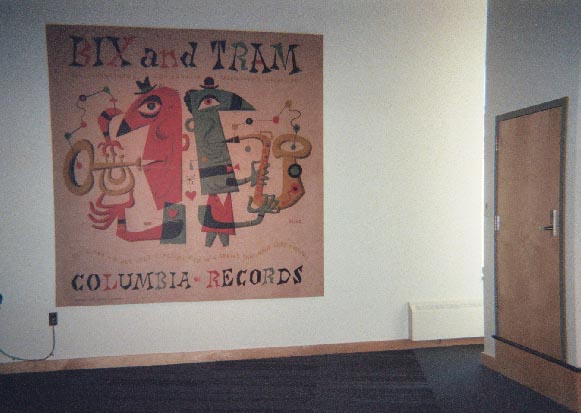
Replica of Capitol Steamboat
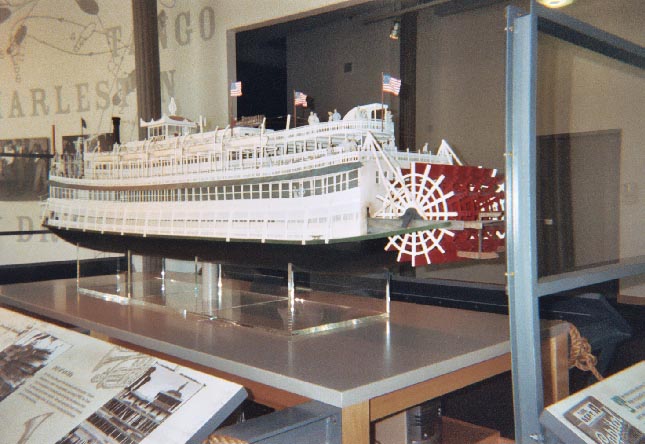
Louis Armstrong and Kid Ory Posters
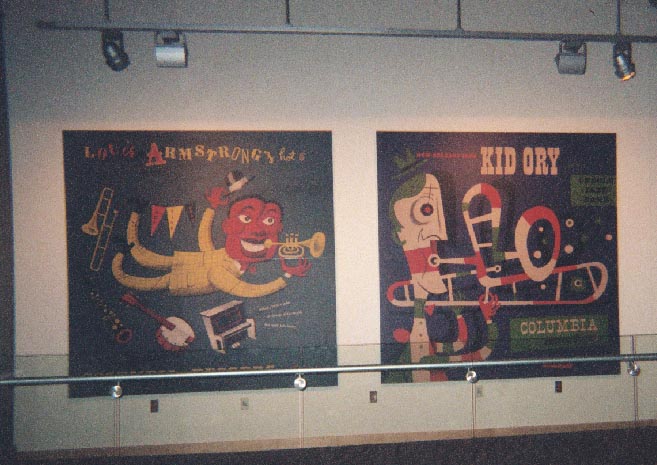
Photos of People Who Attended the Festival
Trumpet Section of Josh Duffee Orchestra. Frank van Nus at far left
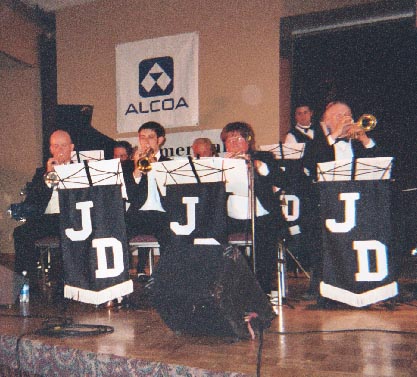
Tom Pletcher Playing with Spats Langham and His Rhythm Boys. From left to right: Norman Field,
Spats, Tom, Frans Sjostrom, Paul Munnery.
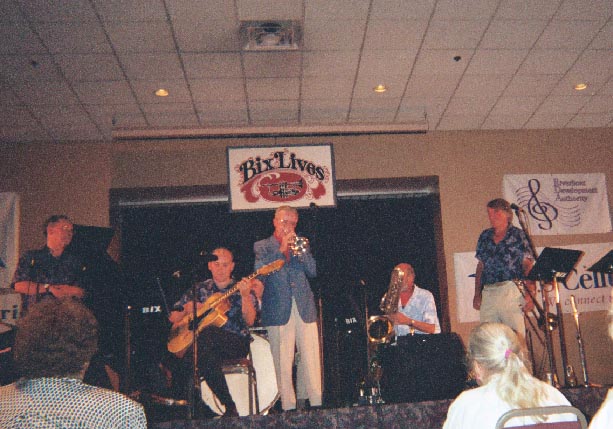
Randy Sandke Playing Bix’s Bach 620 Cornet with Josh Duffee’s Orchestra
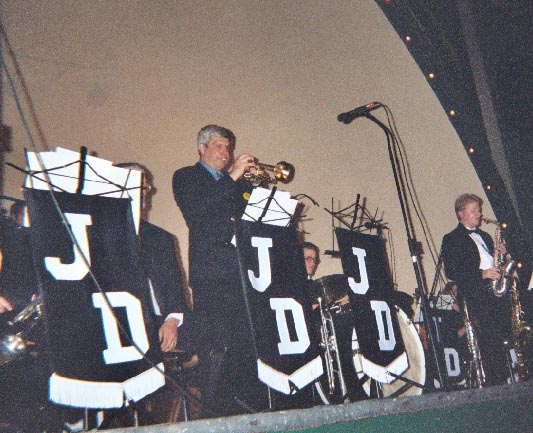
Rich Johnson Receiving Jean Goldkette Award. Standing from left to right: Alann Krivor (grandnephew of Jean Goldkette), Rich, Rickey Bauchelle (daughter of Doc Ryker), Josh Duffee.
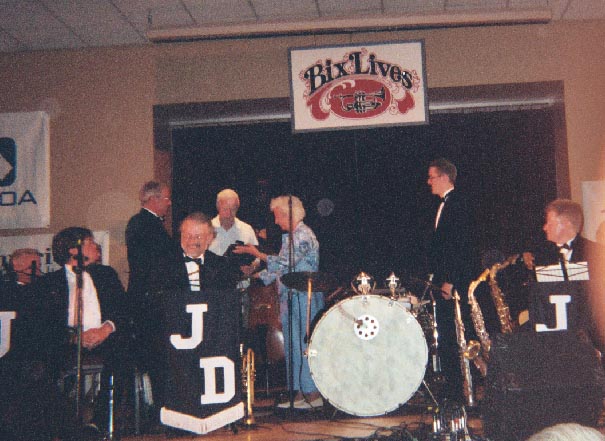
Forumites Sue and Norman
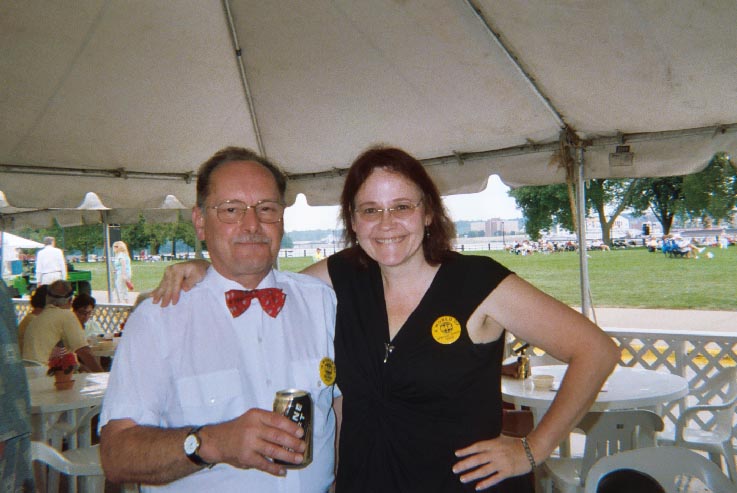
Photos from Flemming Thorbye
Flemming is a devoted Bixophile from Denmark who attends the Festival in Davenport almost every year. He kindly sent the following photographs.
Rich Johnson Accepting Goldkette Award
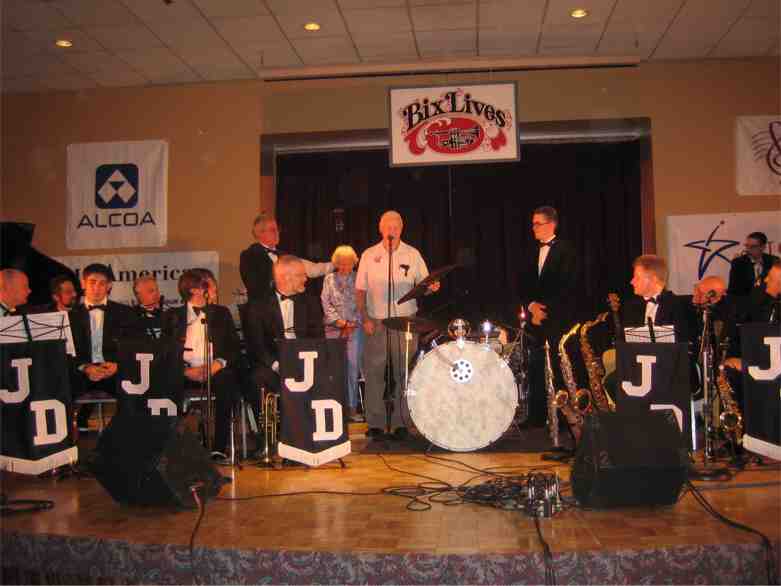
Spats Langham and His Rhythm Boys at LeClaire Park. From lest to right: Jeff Barnhart, piano; Norman Field, clarinet; Spats Langham, banjo; Nick Ward, drums; Mike Durham, cornet; Frans Sjostrom, bass sax; Pul Munnery, trombone.
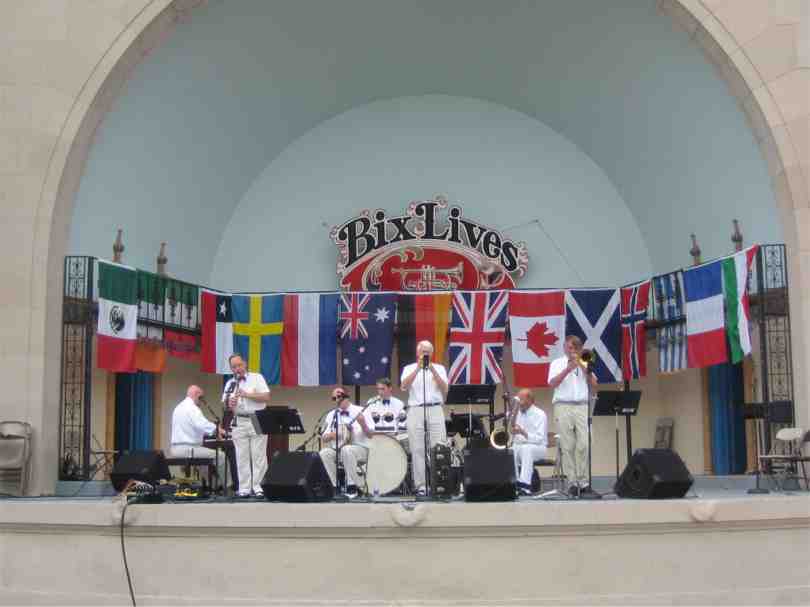
Bix Bust at LeClaire Park
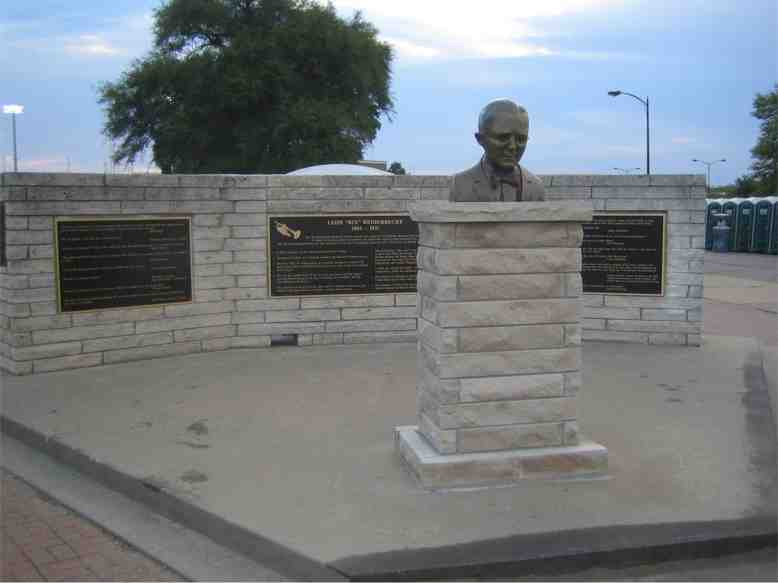
Flemming and His Spouse in Antique Car on the way to Oakdale Cemetery
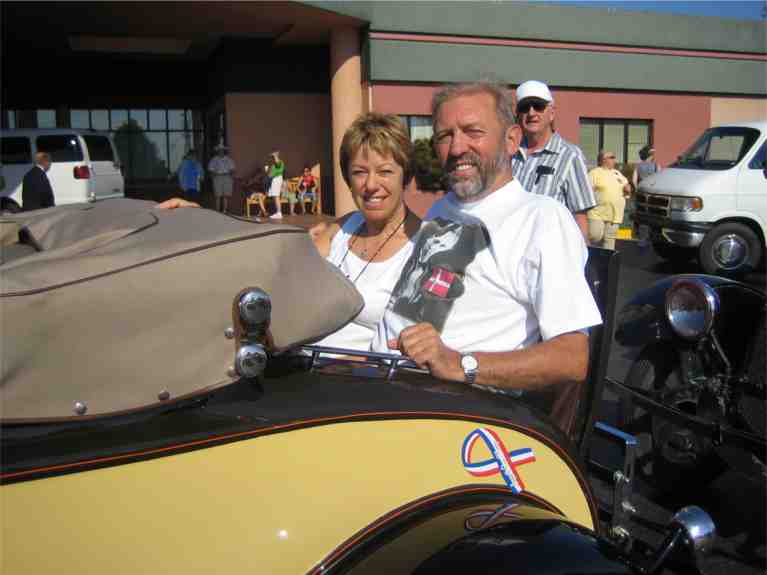
The Bix Beiderbecke Memorial Jazz Band of New Jersey and The Beginning of the Society
Although the idea of of a yearly gathering in Davenport, Iowa, Bix’s hometown, had been discussed in the early fifties and in the sixties, it was not until 1971 that the idea took root. In the early 50’s, it was Bing Crosby, Hoagy Carmichael, Dave Garroway (the host of NBC’s Today show in those days) and Eston Spurrier who suggested a yearly tribute to Bix, but the proposal did not prosper. In the 60’s, jazz musician Robert Stover in conjunction with the Davenport Chamber of Commerce tried to obtain financial support for a tribute, but there was little interest on the part of potential backers.
The break came in 1971 when the Bix Beiderbecke Memorial Jazz Band of New Jersey went to Davenport for the anniversary of Bix’s death. Beginning in 1965, every year, Bill Donahoe, business man, Bix fan extraordinaire, and washboard player, invited friends and jazz musicians from around the Northeast to his home in Long Valley, New Jersey, to play in celebration of Bix’s musical legacy. Bill Donahoe called his yearly gathering the “Bix Beiderbecke Memorial Stomp”. Bix’s nephew, Richard Bix Beiderbecke, who lived in Davenport at the time, attended the annual gatherings.
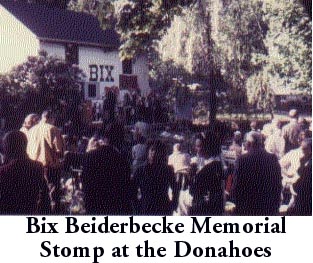
At these gatherings, there was often talk about going to Davenport and play at Bix’s graveside. As a matter of fact, on the occasion of the tenth anniversary of Bix’s death, the Paul Whiteman Orchestra had gone to Davenport and played in Oakdale Cemetery, next to Bix’s place of rest.
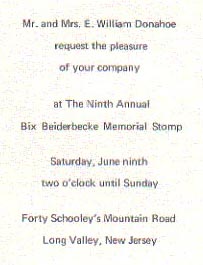
Bill Donahoe had the idea of doing the same in 1971, for the 40th anniversary. Thus, the Bix Beiderbecke Memorial Jazz Band of New Jersey was formed, originally on “a-one-time-only” basis, to play in Oakdale Cemetery. Bill Barnes (cornet player, and at the time the leader of the Southhampton Dixie Racing and Clambake Society; Bill is currently with Rick Fay’s band in Walt Disney World, Florida) was instrumental in putting the band together. Bill Donahoe got in touch with Richard Bix and with Bill Allred (a local jazz musician and leader of the Davenport Jazz Band) and asked their help with the project. Other local musicians/jazz aficionados who helped were Esten Spurrier (cornet player and close friend of Bix’s) and Don O’Dette (cornet player, first president of the Bix Beiderbecke Memorial Society, and son of Jim O’Dette who played with Bix before he left Davenport). Arrangements were made and in the morning of August 6, 1971, exactly forty years after Bix’s death, the Bix Beiderbecke Memorial Jazz Band from New Jersey played at Bix’s graveside. The musicians, all from the New Jersey-New York area, and their instruments were: Joe Ashworth (C-melody sax), Bill Barnes (cornet), Bill Donahoe (washboard), John Gill (banjo), John Schober (clarinet), Jay Duke (drums), [the original drummer in 1971 was scheduled to be Chuck Slate, but almost at the last minute he couldn’t go, and had to be], Skip Strong (trombone), and Bill Taggart (tuba).
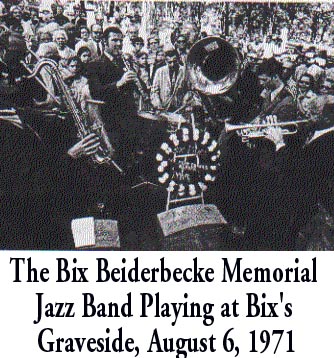
The local antique car enthusiasts provided transportation for the members of the band, newspaper and television reporters covered the story. In addition to Esten Spurrier and Don O’Dette, Doc Ryker, who had played with Bix in the Jean Goldkette Orchestra in 1926/27, Les Swanson, who had played with Bix in the Trave O’Hearn Orchestra in 1929 in Davenport, and Julius Marigold, who had attended Lake Forest Academy with Bix in 1921/22, were present. Robert Cooke, the musician’s union president, placed on Bix’s grave a floral wreath with the words “Bix Lives, Our Most Famous Member”. According to the New York Times with a dateline of Davenport, Iowa, August 7, 1971: “Jazz buffs and musicians wearing “Bix Lives” buttons toasted the jazz immortal Bix Beiderbecke, with early morning champagne and the “Davenport Blues” -the song he wrote for his hometown – over his grave here today. More than 1,500 people gathered before the simple headstone in the Beiderbecke family plot to honor the trumpeter and composer on the fortieth anniversary of his death at age 28 on August 6, 1931.” In his account of the visit, Jerry Verbel, who accompanied the band to Davenport, writes: “Solemnly, the Bix Beiderbecke Memorial Jazz Band did what it came to do. The throbbing and quietly joyous melody that is “Davenport Blues” blanketed Oakdale Cemetery. As the final note drifted away, John Gill (banjo) of Whitestone, Long Island, and a member of the Smith Street Society whispered, “Amen“.”
In the afternoon, the band visited the Davenport Public Library where there was a Bix display and a special event. The original tapes of the nineteen half-hour radio shows (which were to be broadcast later in the year on NPR) prepared by John Grover for his Masters’ degree at Miami University were presented to the Library. Later in the afternoon the band played aboard a Mississippi excursion boat. In the evening the band was scheduled to jam in the basement of the Davenport Holiday Inn together with a local jazz group, the Davenport Jazz Band. The response to the jam session was unprecedented. Hundreds of people showed up, the parking lot of the Inn filled up in no time, and people were forced to park on the highway and walk to the Inn as the local police directed traffic. The attendants were so enthusiastic, that the bands had to jam until the early hours of the morning. This extraordinary event was covered extensively in major U.S. and European newspapers, in magazines (the Mississippi Rag published two long features) and on television. Although the Bix Beiderbecke Memorial Jazz Band of New Jersey had been created for a “one-time-only” appearance, their triumph in Davenport and the associated publicity led to additional performances in major jazz festivals in the U.S. (they returned several times to Davenport to play at the Bix Beiderbecke Memorial Jazz Festival; for several years they play for the Potomac River Jazz Club in connection with their celebration of Bix’s birthday) and in Europe, and to enormously successful recordings (their first LP album sold out in less than one hour in Breda, Holland in 1978). In spite of its popularity and its high level of musicianship, the Bix Beiderbecke Memorial Jazz Band was paid $1.00 and expenses for its appearances. Clearly, these wonderful musicians were totally dedicated to the preservation of Bix’s musical legacy: there was no question of personal profit – it was a labor of love. Let us not forget that Bill Donahoe keeps a clock in his home permanently stopped at 9:30, the exact time of Bix’s death on August 6, 1931.
In view of the phenomenal success of the Bix Beiderbecke Memorial Jazz Band of New Jersey, it became apparent that the idea of a yearly festival in honor of Davenport’s famous citizen was feasible. Thus, not long after the concert at Bix’s grave site and the legendary jam session, a local entrepreneur, Jim Patten, and two local jazz enthusiasts, Don O’Dette and Charles Peart got together and founded the Bix Beiderbecke Memorial Society, the purpose of which was to host a yearly Jazz Festival to preserve and honor Bix’s musical legacy. Additional plans called for the establishment of scholarships for young jazz musicians, the building of a memorial in LeClaire Park, and the purchase of Bix’s childhood home on Grant Avenue to be turned into a museum dedicated to Bix. The first two goals were fulfilled. More than $35,000 have been granted in scholarships and a bust of Bix was erected in the park, together with engraving of quotes from the great jazz musicians Louis Armstrong, Hoagy Carmichael and Paul Whiteman (see photographs of these items) The third goal was not realized. However, the house fell into good hands. Bix’s house, now under restoration, was purchased by the Avati brothers, who directed and produced the film Bix: An Interpretation of a Legend.
Finally, it is worthy of note that Bill Donahoe and the Bix Beiderbecke Memorial Jazz Band of New Jersey went back to Davenport in 1996, on the occasion of the 25th Bix Beiderbecke Memorial Jazz Festival. As many as possible of the original musicians (Joe Ashworth, Bill Barnes and Bill Donahoe) who played in 1971 came back for an encore, “one more time“, and those that could not make it were replaced by Richard Barron (drums), Noel Kaletsky (reeds), Rick Knittel (trombone), Bill Lezotte (banjo), Mike Swanson (tuba) and Tex Wyndham (piano). The Iowa Public Television recorded the LeClaire Park performances of the bands at the 25th festival. The video tape, available from IPTV, includes one of the sets performed by the Bix Beiderbecke Memorial Jazz Band of New Jersey 25 years after they first performed in Davenport.
The original appearance, “one time only“, of the Bix Beiderbecke Memorial Jazz Band of New Jersey on August 6, 1971 can be identified as the singular event responsible for the creation of the Bix Beiderbecke Memorial Society and the Annual Jazz Festival that perpetuates the music and memory of Bix. Bixophiles from all around the world owe a great debt of gratitude to Bill Donahoe.
Additional information can be found in an article by Jim Arpy in “Bix, The Leon Bix Beiderbecke Story“, by Phil and Linda Evans, in “Tommy and Jimmy Dorsey: The Dorsey Years”, by Herb Sanford, in an article by Jerry Verbel for the Leisure West News in January 1998 (the article was reprinted in the March 1998 issue of the Jersey Jazz Magazine and in the July/August issue of Jazz Me News), in an article by John S. Wilson for the Sunday, October 28, 1973 edition of he New York Times and in an article by Kathleen McCarthy.
This section could not have been written without the invaluable help of Bill Donahoe and Jim (Hugh) Donahoe. I acknowledge with appreciation their advice and support. I am greatly indebted to Bill Donahoe for the loan of precious material from his personal collection. I thank Bill Barnes for providing additional information about the members of the band who played in Davenport in 1971.
The Program for the First Bix Beiderbecke Memorial Festival
Following the enormous success of the 1971 visit to Davenport by the Bix Beiderbecke Memorial Jazz Band, the people in Davenport organized the Bix Beiderbecke Memorial Society and in 1972 launched the first Bix Beiderbecke Memorial Jazz Festival. Here is the program for the first Bix Beiderbecke Memorial Jazz Festival.
